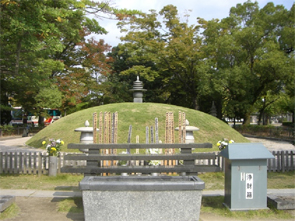
Date of completion
August 5, 1955
Established by
The Society for Praying for the War Dead (Hiroshima City)
Designer
Kikuji Ishimoto
Shape
A round mound formed after an imperial tomb from the Momoyama Period (1583-1600) with a pagoda finial (jap. sourin) made of stone on top (diameter 16m, height 3.5m).
Motive for the erection
To mourn the ashes of the deceased that are unclaimed either because their names are unknown or their families and relatives have died.
Noteworthy characteristics- How the memorial mound came to be
- Inside the mound
- Ecumenical memorial service
This area near the hypocenter was strewn with corpses after the bombing. Innumerable corpses, including those pulled out of the river, were brought here and cremated. In 1946, individual donations enabled the construction of a temporary memorial mound, a temporary vault, and a chapel. Ten years later in 1955, Hiroshima City took over the project and rebuilt the decrepit vault. Unclaimed ashes that had been kept in various other places were also brought to the new vault.
The vault lies under the mound and contains the ashes of roughly 70,000 victims. These were persons whose ashes were unclaimed because the entire family had perished or because they were persons of unknown identity. Every year, Hiroshima City publishes a list of people whose identity has been learned, hoping that relatives will emerge to claim the ashes. Of the 2,432 individual containers of ashes in the vault in 1955, 824 remain unclaimed and continue to rest in this memorial mound. (As of June 20, 2007)
Since 1946, an ecumenical memorial service jointly sponsored by different religions and sects is held in front of the vault on August 6. Regular services are also held on the 6th of every month.